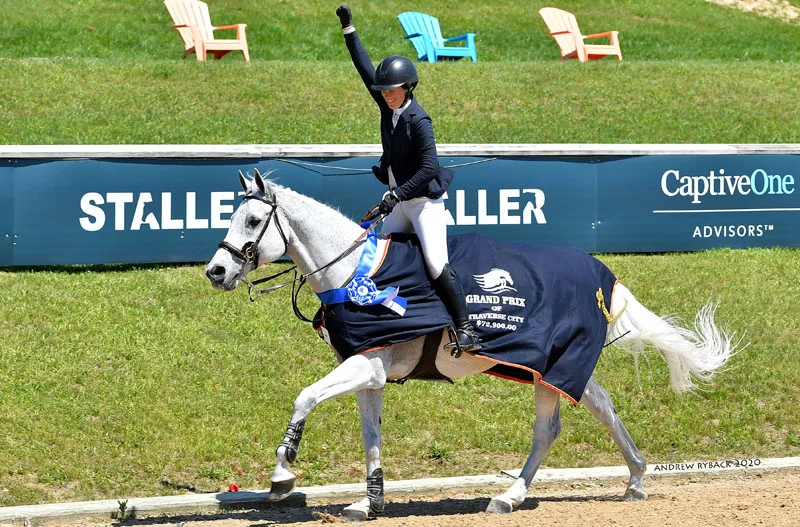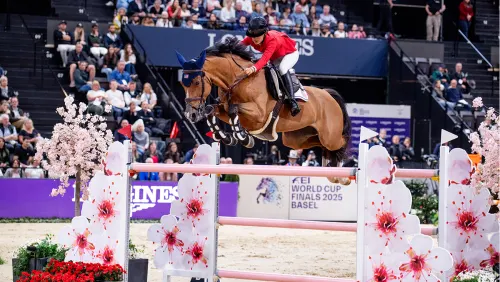Daisy Farish is no stranger to big wins. The 19-year-old from Versailles, Kentucky, has a jaw-dropping résumé in all three rings. A star in the pony hunters and the winner of the 2018 Platinum Performance/USEF Talent Search Finals—East, Farish really hit her stride when she started competing in the jumpers.
She helped Team USA win the Young Rider Challenge Cup at the FEI Jumping Nations Cup Youth Finals (Belgium) in 2018, just weeks after winning young rider individual gold at the Adequan FEI North American Youth Championships (New York). That year she won her second junior jumper championship at Devon (Pennsylvania) and the year before she claimed the Neue Schule/USEF Junior Jumper Individual Championship (Pennsylvania). More recently she helped her team place second at the Wellington CSIOY (Florida) this February. She also won the coveted Maxine Beard Show Jumping Developing Rider Award.
Many of those wins came aboard Great White, a 12-year-old Holsteiner (Cavalor Cumano—Ma July, Julio Mariner), so it’s only fitting that “Bruce” should be her mount for her latest milestone: her first grand prix win. The pair won the $72,900 Turtle Creek Casino & Hotel Grand Prix CSI2* on June 28, the feature event of Week 2 of the Traverse City Spring Horse Show held in Traverse City, Michigan.
Now a professional working for Ken and Emily Smith’s Ashland Farms in Lexington, Kentucky, Farish sees things a little differently than when she was a junior. We caught up with her to hear about her superstar partner and her life as a young professional.

Daisy Farish was ecstatic to win the $72,900 Turtle Creek Casino & Hotel Grand Prix CSI2*. Andrew Ryback Photography Photos
Tell me a little bit about the class. Did the course ride like it walked?
Even though I went last in the class I’d say my plan stayed the same from the time I walked to when I went. It rode the way we walked it. It was a little more technical than the welcome earlier in the week, which was nice. There were a lot clear in the welcome. I thought [the grand prix] produced a perfect number of riders in the jump-off. We decided I really wanted to make the jump-off because I loved the jump-off. I’m happy it worked out.
What was your strategy in the jump-off?
I was lucky enough to go last, so I got to watch most of the riders before me. I had a specific number of strides between all the jumps that I planned on doing. It worked out that way. Other than that my plan was just to make sure I had a strong gallop to the first jump and the rest was as it came.
How does it feel to win your first grand prix?
It was very fun. I was very excited when I came out of the ring. It wasn’t something I’d thought about so much, but then I was like, “Oh wow, I’ve never won a grand prix before; that was exciting.” We didn’t do a whole lot to celebrate afterward, only so much you can do these days with the virus. Had a get-together back at the stalls in the afternoon with the people from the barn. We went back to the house. We went out on the lake. We’ve been tubing and water skiing.
Tell me about your partnership with Bruce.
I got him when he was 7, and he’s 12 now. He’s exceeded my expectations over and over again. I think it’s very nice that obviously I was fairly young when I got him also. A lot of the bigger classes that I’ve jumped have been with him for my first time and his first time also, which is very much a bonding experience. We’ve done a lot of different things together that have been both of our first times to do so. I think that makes it even more special.
ADVERTISEMENT
What were you looking for when you got him?
He had just come available when someone showed him to us. He looked like a very nice horse. Him being young and me being young, I don’t think I necessarily had an expectation of him. He’s grown so much since then. I think he has a lot of heart and quality that it’s nice to see he grew into very well.
What kind of ride does he like?
These days he’s pretty darn easy to ride. He likes to show in his hackamore bridle. Other than that he’s pretty easygoing. Has a nice amount of blood but not too much blood. I like to be able to put leg on at the jumps, which I like to have at the bigger fences. He’s become very rideable. I don’t think there are many tricks.
How long have you been riding him in a hackamore?
He’s been in the hackamore for probably three years. He didn’t ever have a big issue with other bridles, but I never felt like he was super happy to have a bit in his mouth. I don’t know why it never clicked to me to put the hackamore on him. It did at one point, and he was instantly happy and rideable. For many horses, it’s a little bit difficult to turn, or there are certain things you have to sacrifice to ride in a hackamore, but I have to say with him I don’t even notice that I don’t have a bit in his mouth. He goes exactly the same as another horse would with a regular bridle.
What did you have to do to transform Great White from a junior jumper to a grand prix horse?
I have had a lot of help from several people like Andre Dignelli and Heritage Farm, whom I trained with as a junior; they helped me bring him along a lot in those earlier years. Now I’m working with Ashland Farms, whom I work for. They’re helping me with him now. I think that he always had a lot of scope, and it just kind of worked out. As he was getting older, and I was jumping bigger, it was always the right step for him. By the time he turned 9, I was trying to jump bigger classes. So he was ready for that. It was just sort of the natural path that a young horse would take, but instead of jumping young horse classes, I was jumping junior jumper classes.
Tell me about working for Ashland Farms.
I’ve been working here about a year and a half now. I’d just turned pro when I started working for them. I was lucky that as an 18-year-old they were willing to give me an opportunity. I love working for them. One thing that they have at Ashland Farms is definitely a lot of horses. I’m very lucky I get to show so many horses every week, and that’s thanks to them. The other thing I’ve gotten the opportunity to learn how to do is train. They have a sales barn as well, and I get to ride a lot of horses that are for sale that they own and the client horses that I get to train. I think it’s helped me become—and still becoming obviously—much more well rounded.
Did you turn pro as soon as you aged out?
I had a few months as an amateur in Florida and then just at the end of [the Winter Equestrian Festival (Florida)] is when I started working for Ashland and became a professional.
ADVERTISEMENT
Talk about the transition from being a junior rider to a professional. I know it’s really hard for a lot of people to age out.
I have to say I think I was ready to be out of the juniors. I had a long run; I was showing for a long time in the equitation. Even though it’s bittersweet, I was ready for the next step. I was excited for that. For sure it’s a little bit of a transition, with a little bit more responsibility. It’s a little bit of an adjustment being so young and being close in age to the juniors. For me, I didn’t think it was that difficult for me to separate that, but for some people it is.
What’s a typical non-showing day like for you?
If we were at our home base for the summer, which would be Lexington, Kentucky, I get to the barn at 7:30, and I would, depending on the day, whether we’re setting a course or whatever we’re doing, then I’d start riding about 8:30. I would ride between six and 10 horses, and then at some point depending on when the kids are coming, I’ll have breaks for lessons. Generally, at the end of the day we have a task at the barn, whether that’s setting a course in the field or painting jumps. We’re always up to something.
Do you ride mostly jumpers or do you do hunters as well?
I do quite a few hunters as well. I do them pretty evenly honestly. I do a lot more hunters now than I did as a junior. I enjoy that also. When I was a junior I never had a hunter myself, but I did [catch ride] some. I did [USEF Junior Hunter Championships] and some of the indoors.
What are your goals, short term and long term?
Short term, I just want to keep continuing to be successful, both at my job at Ashland, and I want to continue growing as a show jumping rider. I want to be able to compete in FEI classes and bigger classes. Long term, I don’t know that I’d point out a specific thing I’d like to accomplish. One goal definitely is to be a show jumping rider and hopefully one day be able to represent the United States on senior Nations Cup teams if I’m lucky enough to.
What’s the biggest difference between being a junior and a pro?
I’d say for me it’s getting a bigger picture of the horses you’re riding. For me, there are horses that we’ve imported I’ve been working with for six months or a year that I’m watching progress and trying to improve or grow with the horse. I didn’t do that with most horses I rode as a junior. A lot of the horses I rode as a junior I would meet at the show because they were with a different trainer, and I was catch riding. It was more of an in-the-moment thing as a junior. I love to be learning more about developing horses and fitting them to riders. I do a lot more horse management [than when I was a junior]. We do have barn manager roles other than me, but I’m much more involved. I was involved with my horses’ day-to-day care [as a junior], but overseeing the whole barn in some type of way was new for me.
How has the pandemic affected you and your training?
For sure it was an adjustment not showing for an extended period of time. That might have been the only time I’ve ever done that since I was 6 years old. Not to sound naïve, because I’m not at all grateful for this virus, but I do think it was a nice break for the horses, and I think that our kids in the barn had a lot of chances to improve in their riding back to the basics, instead of showing, showing, showing. The horses can have lessons and jump because they’re not about to show the following week. For myself, I took the opportunity to get Bruce very, very fit, which paid off a lot. I was excited to get back to Kentucky and ride him out in the fields every day for long periods of time.















